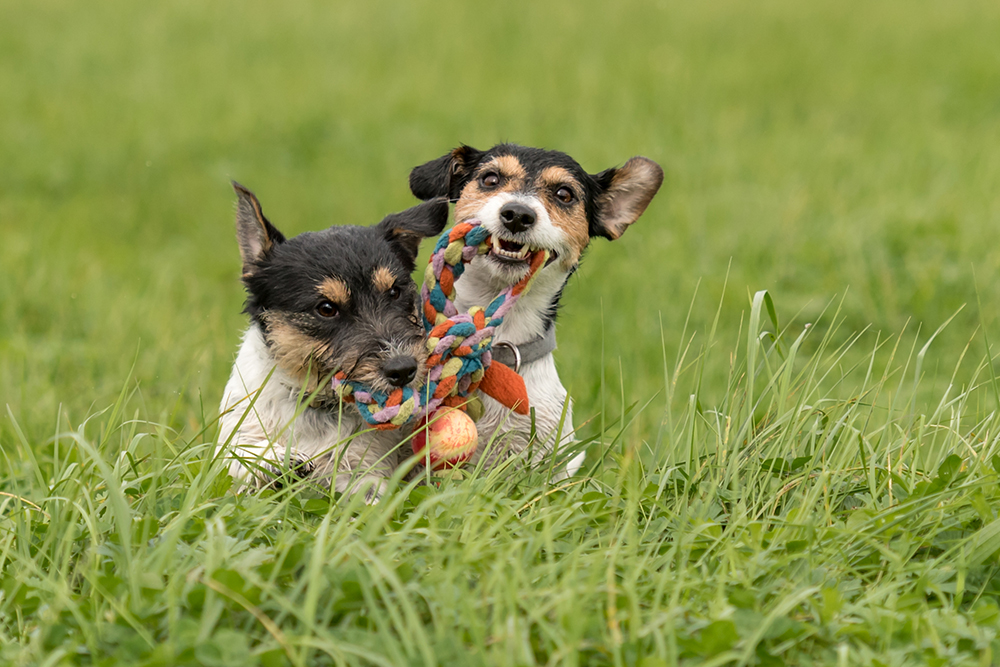Learn : Exercise & Enrichment
How to Teach Your Dog to Play Fetch
There you all are.
Your loyalest companion. A ball sized just right for your dog’s toothy grasp. The sun’s warm, endorphin-releasing rays. And nothing but yards of safe, enclosed, unobstructed backyard between you.
Annnnnd FETCH!
GO GET IT!
GET IT BOY!
GET IT!
MUSH! CHOP CHOP! VAMOS!
...And yet, still nothing.
Don’t let your dog’s inertia confuse or irritate you — while TV and movies may make it appear like fetch comes as part of a canine’s standard operating system, the truth is, most dogs take some education before they’re playing the game the way it was meant to be played.
Some breeds — the Border Collie, the Labrador Retriever, or Aussie Shepherd, for example — may already have a fetching instinct built in, others’ breeding pedigrees and vocational histories may not lend themselves to the game at first blush.
But fear not. With some time and patience, most dogs can learn to play fetch, and in time, learn to love it.
Step 1 — Start with a few commands
Is your dog already familiar with the basics? Sit? Stay? Paw?
The better your dog learns to listen, the easier the fetch training process will be. When associated with positive feedback such as treats, pets and verbal affirmations, basic dog training has proven itself as the most effective prerequisite for teaching dogs any complex command, fetch included.
The three commands trainers find most helpful in teaching fetch are sit, come and drop it. With these three in two, fetch is nothing more than putting the pieces together between them.
Step 2 — Find a familiar environment
Once your dog feels comfortable listening to you, make sure you start the training process somewhere comfortable, familiar and unchallenging. This could be an outdoor space the two of you frequent (e.g. the backyard or a local park), or even the living room (provided you have ample space, a smaller breed and a softer ball that won’t damage furniture).
The fewer stressors within the environment, the better your dog will respond to training. Do they struggle with squirrels? No friend to birds? What about neighbors’ dogs or construction noises? Do what you can to minimize outside interference before you begin training.
Step 3 — Start simple
Find a ball your dog likes (some may be more partial to hard materials, while others — especially those with sensitive teeth — may be more partial to softer materials) and practice simply tracking the ball. Toss the ball out in front of you at least 5-10 ft and say “fetch.” It’s likely your dog will chase the ball, grab it and then do whatever they please.
For now, that’s good enough. Retrieve the ball from then and repeat the process, over and over, saying “fetch” to help build the association between the game and the ball trotting out in front of them.
Step 4 — Practice “come”
Once your dog is consistently chasing the ball, welcome them back with the “come” command. High value may come in handy here, as an excitable dog may find the ball a treat in itself.
Allow for them to make contact with the ball, and immediately call “come.” When they do return with the ball, immediately reward them with a treat.
Step 5 — Practice “drop it”
As your dog responds to the “come” command, “drop it” may be your final piece of the puzzle. Once your dog returns with the ball at about an arm’s length, calmly say “drop it.” Do your best to reward them only after taking the action, rather than baiting them into it with the treat.
Repeatedly practicing “drop it” will eventually build in the association that releasing the ball will result in good things to come for your dog.
Step 6 — Put it all together
In time, throwing the ball and saying “fetch” will become your dog’s marker to sprint, retrieve the ball and drop it all in one command. If necessary, you may want to practice on a leash so that you can quickly abort any failed attempts or miscues.
It may sound strikingly simple, but think of each step as a days- or even weeks-long process. Consistency, repetition and positive reinforcement are the hallmarks of a successful training, and fetch is no different.
Keep at it, keep them engaged and you’ll be fetching in no time.



 Are my dogs playing or fighting?
Are my dogs playing or fighting?
 How to Introduce a Dog to a Baby
How to Introduce a Dog to a Baby
 How Dogs Show Their Love
How Dogs Show Their Love
 An Annotated History of Dog Food
An Annotated History of Dog Food
 The 12 Pet-Friendliest Professions
The 12 Pet-Friendliest Professions